Orthostatic high blood pressure, also referred to as postural hypertension, is a problem characterized by a sudden rise in high blood pressure when a person stan testoyds up from a sitting or existing position. This can bring about a range of signs and symptoms such as wooziness, impaired thinking, as well as fainting. Understanding the sources of orthostatic high blood pressure is vital in order to efficiently take depanten care of as well as treat this problem.
Autonomic Nerves Disorder
Among the primary causes of orthostatic high blood pressure is dysfunction in the free nervous system. The free nerves is accountable for managing various physical functions, including blood pressure. When this system malfunctions, it can cause unusual high blood pressure reactions, such as an extreme rise in blood pressure upon standing.
In some cases, free nerves disorder can be brought on by underlying clinical problems, such as diabetes, Parkinson’s disease, or multiple system degeneration. These problems can disrupt the normal performance of the free nervous system, bring about orthostatic hypertension.
Furthermore, specific drugs, such as alpha-blockers or beta-blockers, can also interfere with the autonomic nervous system as well as add to orthostatic hypertension. These medications are commonly suggested to deal with problems like hypertension, however they can sometimes trigger an abrupt decrease in high blood pressure when standing, resulting in orthostatic hypertension.
Dehydration
Dehydration is an additional typical cause of orthostatic hypertension. When the body is dried out, there is a reduction in blood quantity, which can result in a fast boost in high blood pressure upon standing. This is since the body attempts to make up for the decreased blood quantity by enhancing the stress to keep ample blood flow to the mind as well as other essential organs.
Dehydration can take place for numerous factors, including insufficient liquid consumption, too much sweating, vomiting, or looseness of the bowels. It is necessary to stay effectively moistened, particularly in heat or during exercise, to prevent dehydration-related orthostatic high blood pressure.
People with problems that influence fluid balance, such as diabetes mellitus insipidus or adrenal deficiency, are at an increased risk of developing orthostatic hypertension because of dehydration.
Age-related Modifications
As we age, our bodies undertake numerous modifications, including changes in capillary and also the free nervous system, which can add to orthostatic high blood pressure. Elderly people may experience reduced versatility in blood vessels, resulting in reduced capacity to tighten or dilate in feedback to adjustments in body position.
Moreover, age-related changes in the autonomic nerves can result in damaged law of high blood pressure upon standing, resulting in orthostatic hypertension. The specific mechanisms behind these age-related modifications are still not totally understood, yet they are thought to be multifactorial.
Elderly individuals are also more vulnerable to other threat aspects for orthostatic hypertension, such as drug usage as well as underlying clinical problems, making them extra prone to developing this problem.
Therapy as well as Management
Orthostatic hypertension can dramatically impact an individual’s lifestyle and boost their danger of drops as well as various other complications. Therefore, handling as well as treating this problem is crucial.
- Liquid consumption: Staying adequately moistened is important in protecting against dehydration-related orthostatic high blood pressure. Consuming water throughout the day as well as raising fluid intake during heat or physical activity can assist maintain appropriate blood volume.
- Avoid unexpected movements: Slowly transitioning from a sitting or lying position to standing can help lessen the abrupt rise in high blood pressure. This can be achieved by taking a few minutes to stay up and then stand progressively.
- Compression stockings: Using compression stockings can aid improve blood circulation and lower the merging of blood in the reduced extremities, thus assisting to prevent orthostatic high blood pressure.
- Medicine changes: If drugs are causing or adding to orthostatic hypertension, a health care professional might think about adjusting the dose or switching to different medicines.
- Lifestyle modifications: Engaging in routine exercise, maintaining a healthy and balanced diet plan, and also avoiding extreme alcohol consumption can contribute to general cardiovascular wellness as well as aid take care of orthostatic hypertension.
- Medical treatments: In extreme cases, where way of life modifications and conservative actions do not successfully manage orthostatic hypertension, a healthcare expert might think about prescribing medications that help control high blood pressure.
Conclusion
Orthostatic hypertension is a condition characterized by a sudden increase in high blood pressure upon standing. Dysfunction in the free nerve system, dehydration, and age-related modifications are some of the principal root causes of this condition. Understanding these causes is critical in order to effectively handle and also treat orthostatic hypertension. With proper therapy and way of living alterations, people with orthostatic high blood pressure can lead a much better quality of life and also reduce the danger of difficulties.
